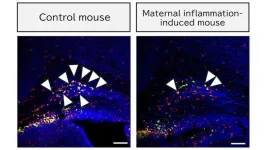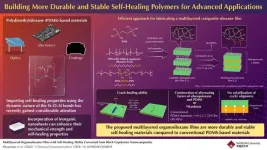Senolytics target Alzheimer’s-linked brain enzymes without harming healthy ones
“This work provides new opportunities for the development of the next generation of ChE inhibitors that specifically target AChE and BChE associated with AD pathology.”
2025-04-01
(Press-News.org)
“This work provides new opportunities for the development of the next generation of ChE inhibitors that specifically target AChE and BChE associated with AD pathology.”
BUFFALO, NY — April 1, 2025 — A new research paper was published in Aging (Aging-US) on March 29, 2025, as the cover of Volume 17, Issue 3, titled “Differential senolytic inhibition of normal versus Aβ-associated cholinesterases: implications in aging and Alzheimer’s disease.”
In this study, a research team from Dalhousie University, led by Sultan Darvesh, discovered that certain anti-aging compounds, known as senolytics, can block harmful brain enzymes linked to Alzheimer’s disease (AD) without affecting healthy ones. Senolytics are compounds that help clear out damaged or “zombie” cells that build up with age and contribute to inflammation and tissue dysfunction. This work provides new insight into how AD-related damage can be precisely targeted, leading the way for safer treatments that protect memory and brain health in older adults.
Alzheimer’s disease is one of the most common causes of memory loss and dementia. A hallmark of the disease is the buildup of sticky protein clumps in the brain, known as amyloid-beta plaques. Two enzymes—acetylcholinesterase (AChE) and butyrylcholinesterase (BChE)—are found near these plaques. While these enzymes play important roles in brain function, they can also contribute to AD progression when they attach to plaques. Drugs that target these enzymes are already used to help with memory, but they often block both harmful and healthy forms, which can cause unwanted side effects.
To investigate a better solution, researchers tested six compounds that are known for their anti-aging or brain-boosting properties. They wanted to know if these compounds could block only the harmful AChE and BChE enzymes forms linked to Alzheimer’s disease. Using brain tissue samples from AD patients and enzyme activity assays, they discovered that compounds such as dasatinib and nintedanib, both senolytics, were able to block the forms of AChE and BChE associated with amyloid-beta plaques. These compounds did not affect normal brain enzymes, though.
“We show that the selected senolytics and nootropic inhibit ChEs associated with plaques but not the enzymes associated with normal neural elements.”
The study also used computer modeling to explore how these compounds interact with the enzymes. The models showed that the enzymes change shape when near plaques, making them easier for certain compounds to target. This change may explain how the drugs can selectively affect only the diseased areas of the brain.
While not all compounds worked equally well, the findings offer a new strategy for treating AD. By focusing on the differences between healthy and diseased enzyme forms, researchers may be able to design more precise and effective therapies. This selective approach could improve memory, reduce inflammation, and avoid the side effects of AD’s current treatments.
In summary, this research opens new possibilities for treating Alzheimer’s disease in a more targeted way. It also highlights how discoveries in aging and brain health can work together to create better therapies for neurodegenerative diseases.
Read the full paper: DOI: https://doi.org/10.18632/aging.206227
Corresponding author: Sultan Darvesh- sultan.darvesh@dal.ca
Keywords: aging, cellular senescence, β-amyloid, acetylcholinesterase, butyrylcholinesterase, cholinesterase inhibitors
Click here to sign up for free Altmetric alerts about this article.
___
Please visit our website at www.Aging-US.com and connect with us:
Facebook
X
Instagram
YouTube
LinkedIn
Reddit
Pinterest
Spotify, and available wherever you listen to podcasts
Click here to subscribe to Aging publication updates.
For media inquiries, please contact media@impactjournals.com.
Aging (Aging-US) Journal Office
6666 E. Quaker St., Suite 1
Orchard Park, NY 14127
Phone: 1-800-922-0957, option 1
END
ELSE PRESS RELEASES FROM THIS DATE:
2025-04-01
A research group led by Nagoya University Graduate School of Medicine in Japan has uncovered a potential mechanism linking maternal inflammation to delayed neurodevelopment in infants. The research suggests the role of CD11c-positive microglia—immune cells in the brain crucial for myelination—during infant brain development. The results, published in Communications Biology, suggest new strategies to mitigate the long-term neurodevelopmental effects of maternal inflammation.
Inflammation during pregnancy occurs when the mother’s immune system becomes activated during pregnancy, typically due to an infection, autoimmune response, or environmental factors. ...
2025-04-01
North America’s smallest falcon, the American Kestrel (Falco sparverius), has declined across the continent since the 1970s, yet the causes continue to stump raptor biologists. A new study published in the Journal of Raptor Research adds a piece to the puzzle with the discovery that in the Northeast, where declines are most alarming, fledglings demonstrate a relatively high survival rate. This paper, titled “Juvenile and Adult Survival Estimates of American Kestrels Throughout the Full Annual Cycle in Eastern North America,” is the first of its kind. No other study has assessed winter survival ...
2025-04-01
Linoleic acid, an omega-6 fatty acid found in seed oils such as soybean and safflower oil, and animal products including pork and eggs, specifically enhances the growth of the hard-to-treat “triple negative” breast cancer subtype, according to a preclinical study led by Weill Cornell Medicine investigators. The discovery could lead to new dietary and pharmaceutical strategies against breast and other cancers.
In the study, published March 14 in Science, the researchers found that linoleic acid can activate a major growth pathway in tumor cells by binding to a protein called FABP5. Comparing breast cancer subtypes, the team observed that this growth pathway activation ...
2025-04-01
As of the end of 2023, nearly 40 million people worldwide were living with HIV, including approximately 1.2 million in the United States. In the same year, about 630,000 people globally died from AIDS-related illnesses. Although this is a significant decline from previous years, AIDS-related deaths remain a critical global health challenge.
While antiretroviral therapy (ART) has improved the life expectancy of people with AIDS, a lack of effective diagnostics and disease management tools has hindered its global implementation. Only 59% of those in need have access to treatment, and about one in four people living with HIV are unaware of their status. Additionally, ...
2025-04-01
Cardiac deaths increase significantly during compound heatwaves—heatwaves where temperatures are elevated both during the day and overnight—according to a new study in JACC, the flagship journal of the American College of Cardiology. The study also found that some types of heart disease are more sensitive to heatwaves than others and that different types of heatwaves may impact heart health in distinct, nonlinear ways.
The research highlights the special risks of compound heatwaves ...
2025-04-01
DALLAS, April 1, 2025 — A New York City-based physician scientist who explores ways to improve health by looking at the ways in which cells and molecules impact disease and an epidemiologist from Baltimore who has devoted her career to identifying ways to improve screening, diagnosis and patient care for people with diabetes are the most recent American Heart Association Merit Award recipients. Over the next five years, each researcher will receive a total of $1 million in funding from the Association, a global force changing the future of health for all.
The American Heart Association’s Merit Award is one of ...
2025-04-01
A study of the use of AI by a Russian-backed propaganda outlet shows how AI allows propagandists to increase their production capacity without any loss in persuasive power. In December 2023, journalists at the BBC and Clemson University’s Media Forensics Hub published an investigation revealing that the site DCWeekly.org was a Russian propaganda outlet, part of a broader network disseminating pro-Kremlin and anti-Ukrainian narratives. Morgan Wack and colleagues found that prior to September 20, 2023, much of the content on the site was simply lifted from other right-leaning outlets. After that date, however, the stories were generally rewritten by AI, allowing the site to use a broader ...
2025-04-01
Polysiloxane materials, such as polydimethylsiloxane (PDMS)-based elastomers, exhibit a self-healing capability by the introduction of silanolate (Si–O–) groups. This ability stems from their dynamic siloxane (Si–O–Si) bonds, which can break and reform to repair damage. Their self-healing properties could make them valuable in applications like protective coatings for use in various fields, such as optics, electronics, and aerospace.
To improve the properties of PDMS-based materials, they have been combined with inorganic fillers such as nanoparticles or nanosheets. Generally, the introduction of nanosheets into polymers leads to the formation of ...
2025-04-01
New York, NY – April 1, 2025- A study published today in the American Journal of Gastroenterology reveals significant disparities in healthcare utilization among racial and ethnic groups with inflammatory bowel disease (IBD) in the United States. The research, funded by the Centers for Disease Control and Prevention (CDC), led by investigators from the University of Pennsylvania, the University of North Carolina at Chapel Hill, and the Crohn's & Colitis Foundation provides crucial insights into the challenges faced by underrepresented communities ...
2025-04-01
DALLAS, April 1, 2025 — Sedentary behavior has become a national health crisis, with 1 in 4 U.S. adults sitting for more than eight hours a day, increasing their risk for heart disease, stroke, and mental health challenges, according to the Centers for Disease Control and Prevention. To help people move more, the American Heart Association, a global force changing the future of health of all, invites communities nationwide to walk together on Wednesday, April 2.
Adopting healthier routines doesn’t have to be intimidating or overwhelming according to Eduardo Sanchez MD, MPH, FAHA, the ...
LAST 30 PRESS RELEASES:
[Press-News.org] Senolytics target Alzheimer’s-linked brain enzymes without harming healthy ones
“This work provides new opportunities for the development of the next generation of ChE inhibitors that specifically target AChE and BChE associated with AD pathology.”






